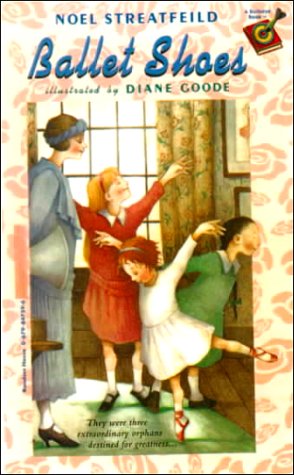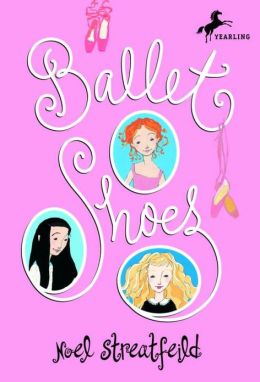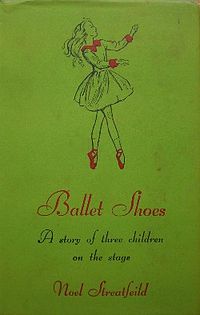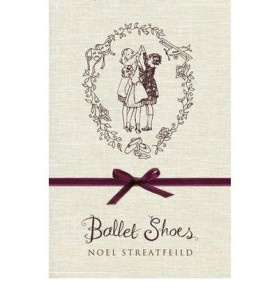Noel Streatfeild Read-Along: Ballet Shoes
Finally! I didn’t want to post this while so many of you were unable to load the site. So let’s talk, already!

Ballet Shoes was Noel Streatfeild’s first children’s novel, published in 1937. She had already published a handful of novels for adults by this point, beginning in 1931. Before that, she worked as an actress for ten years—a somewhat unusual profession for an English vicar’s daughter at that point in time. Her experience in the world of the theater became fodder for the “Shoe” books, her most popular works and the ones for which she is best remembered nowadays.
In Ballet Shoes, we meet our first set of plucky children bound for the stage (whether they like it or not). Pauline, Petrova, and Posy Fossil aren’t sisters by birth; they are adopted by an eccentric explorer known to them as as Gum—that is, Great-Uncle Matthew. Gum collected each of them as babies, depositing them in the large house run by his great-niece, Sylvia, and her former nanny, and disappearing again. He visits infrequently and stays only long enough to drop off his latest collection of fossils or orphaned infants. All the girls really know of him are their origin stories, which loom large in their minds, and in homage to which they have chosen their distinctive surname.
Now six years have passed since anyone heard from Gum, and the money has run out. Sylvia, middle-aged and growing anxious, is worried about how to keep the house running and pay for the girls’ education. Her stopgap solution is to take on some boarders, and a luckier assortment of lodgers cannot be imagined. There’s Theo, who teaches dance at a ballet school that is to shape the Fossil girls’ future; the Simpsons, a young married couple home from India, sporting a shiny new automobile (the joy of Petrova’s life); and two retired female professors, Dr. Jakes (English literature) and Dr. Smith (mathematics), who are looking for a quiet place to devote themselves to research.
 By the time the housekeeping money Gum has left runs out for good, the boarders have all fallen in love with the house and the girls, and they eagerly step in with solutions when Sylvia is at her wit’s end as to how to keep the house running. Theo convinces her to enroll all three girls in Madame Fidolia’s dance academy, where she teaches, in order to provide them a way to earn their livings when they’re older. They can begin performing for pay at age twelve, she explains, and despite initial trepidations, Sylvia agrees that the girls will be well served by having a means of income in case Gum never returns from his wandering.
By the time the housekeeping money Gum has left runs out for good, the boarders have all fallen in love with the house and the girls, and they eagerly step in with solutions when Sylvia is at her wit’s end as to how to keep the house running. Theo convinces her to enroll all three girls in Madame Fidolia’s dance academy, where she teaches, in order to provide them a way to earn their livings when they’re older. They can begin performing for pay at age twelve, she explains, and despite initial trepidations, Sylvia agrees that the girls will be well served by having a means of income in case Gum never returns from his wandering.
Her worries about their education are put to rest by the good professors, who confess to finding retirement a bit dull. And so the girls begin their tenure at the Children’s Academy of Dancing and Stage Training, studying ballet, acting, and French, and learning the ins and outs of backstage life. This is where Streatfeild’s genius lies and what sets the Shoe books apart from other novels about English orphans: she invites us into a world of dance classes and auditions, costume changes and licensing examinations, pantomimes and newspaper reviews. With brisk, beguiling strokes, she paints a picture of busy, dedicated children working hard at their craft. Even Petrova, who hates dancing, toils doggedly away, her mind on cars and airplanes but her muscles devoted to the task at hand. The “so you can earn your living” spin is fascinating (and unusual); it’s far more common in literature to see an aspiring young dancer/actor/artist/etc struggling for validation in a world populated by adults pooh-poohing the dream. Here, instead of starry-eyed dreamers, we have stalwart little workers. Even Posy, who possesses such remarkable innate ability that she commands the attention of Madame Fidolia herself, is not portrayed as a head-in-the-clouds dreamer. She approaches her training with a serious, matter-of-fact manner that amuses her elders and annoys her sisters, and when (at a very tender age) Posy deems certain classes beneath her ability and therefore not worth her time, she blows them off with that same matter-of-fact, business-as-usual manner. It’s not so much that Posy dreams of being a famous ballerina; it’s that even as a tiny child, she knows in her bones that she will be a famous ballerina and sets about working toward that inevitable future in the most practical manner.
 By bypassing the romantic storytelling tropes associated with the aspiring-performer plot, Streatfeild lets us experience the London stage as she must have experienced it: the schedules and commutes, the nervewracking auditions, the disappointments and triumphs, the rehearsals, the backstage bustle that is so much more central to a stage performer’s life than the brief moments of applause at the end of a show. Even as Pauline, a gifted actress (thanks in large part to Dr. Jakes’s coaching), thinks more about the tedium of a film actor’s routine than about her rave reviews and admiring fans. And I love this about Ballet Shoes: its very British prosaicness.
By bypassing the romantic storytelling tropes associated with the aspiring-performer plot, Streatfeild lets us experience the London stage as she must have experienced it: the schedules and commutes, the nervewracking auditions, the disappointments and triumphs, the rehearsals, the backstage bustle that is so much more central to a stage performer’s life than the brief moments of applause at the end of a show. Even as Pauline, a gifted actress (thanks in large part to Dr. Jakes’s coaching), thinks more about the tedium of a film actor’s routine than about her rave reviews and admiring fans. And I love this about Ballet Shoes: its very British prosaicness.
But prosaic never, in this book, equals boring—and the several threads of suspense that run through the novel keep us always in a state of pleasant anxiety. Will Pauline get the part? Will Gum return before the money runs out? Will Sylvia have to sell the house? Will Nana find a way to pay for a new and terribly necessary audition dress? Will Petrova mortify herself onstage? Will Posy—nah, there’s never any suspense about Posy. She simply won’t allow it.
The portrayal of the performing-arts world may be realistic rather than romantic, but the fates of our three heroines contain as much romance as any young reader could wish for. Pauline becomes a film star! Posy, the famous ballerina she always knew she would be. And Petrova, thanks to her mechanically minded kindred spirit, Mr. Simpson, gets to spend plenty of time tinkering with machines during her offstage hours. When she is presented with her very own pair of overalls in Mr. Simpson’s garage—and we’re told the head mechanic always saves jobs for her to do—there’s romance there a-plenty. And of course it’s Petrova the future aeronaut who will, according to her confident sisters, be the one to achieve the goal the three orphan girls have been vowing to pursue since they were tiny: to one day put the Fossil name, their own unique name, in the history books.
 This is what I love about Streatfeild. Her books are full of unlikely coincidences (imagine the luck of that particular assortment of boarders landing on Sylvia’s doorstep) and eccentric characters, and yet she presents them in such a straightforward, everyday manner that it all seems perfectly plausible. Of course the infant Pauline survives a sunk ship and is rescued by an absentminded fossil-hunter; of course a noted Shakespearean educator winds up in charge of her education; of course she becomes a celebrated child actress. What could be more inevitable? Now what’s for tea?
This is what I love about Streatfeild. Her books are full of unlikely coincidences (imagine the luck of that particular assortment of boarders landing on Sylvia’s doorstep) and eccentric characters, and yet she presents them in such a straightforward, everyday manner that it all seems perfectly plausible. Of course the infant Pauline survives a sunk ship and is rescued by an absentminded fossil-hunter; of course a noted Shakespearean educator winds up in charge of her education; of course she becomes a celebrated child actress. What could be more inevitable? Now what’s for tea?
There’s lots more I could say, but I’ll turn the floor over to you now. I’m eager to hear your thoughts.
(Does it kill you when they sell the house and scatter? Because it kills me. Does Nana like living in Czechoslovakia, do you think?)
Next up in our Streatfeild read-along: Dancing Shoes.

Little Willow says:
This was the first Noel book I read, and my favorite. It is also one of the first books that I used as a jumping-off point for my own book, starting a story with three orphan girls who are adopted by the same fellow, written when I was about six years old!
On March 21, 2013 at 4:54 pm
Melissa Wiley says:
Ooh! Do you still have a copy? I want to read it! 🙂
On March 21, 2013 at 4:55 pm
Kemara says:
I’ve read all of the “Shoes” books, but “Ballet Shoes” was the first, and has a special place in my heart. Ever since I was little I’ve been enchanted by the grace and power dance and gymnastics. I have cerebral palsy so there was never a chance of my being good at either one, but as a child, I didn’t know that.
I lived the drama of auditions and classes right along with the Fossils. I learned from them that if you truly love something, you work as hard you can to achieve it. You might not get there, but it’s the journey that matters. In the journey you meet yourself.
As a teen and and adult I went on to ride horses, take ballet, clogging, Scottish Country dance and Irish step dance classes. Was I spectacular? No, but I loved every minute of the journey.
On March 21, 2013 at 6:10 pm
Miranda says:
It was such fun reading this book again. And I really enjoyed experiencing the story as a mother of three girls, rather than as a girl myself. I wonder whether children in those days were really so apparently well-behaved and able to sit still in a way mine seem to find impossible.
It was interesting that you focused on the almost mercenary attitude of the two eldest girls to their careers. Even Pauline, supposedly naturally talented and drawn to the stage, throws it all to the side in order to help her sister. This really stuck out for me when I read the book this time, and I can’t imagine that the world of child acting is at all like this today. I am under the impression it is only the lucky(?) few who actually make any money. I wonder how e a contemporary insider’s perspective would compare.
I also noticed the necessary anxiety over clothing, and its relative expense in those days compared to today. Let alone the heroic work of Nana et al in making up three sets of outfits at a moments notice! And her reward? Living out her final years alone in Czechoslovakia with only Posy and her ballet for company. Amazing how Streatfeild just blithely sends her off without even a comment! Poor Nana… We can only hope she will be rescued when Posy reaches her majority.
On March 21, 2013 at 7:09 pm
Elizabeth H. says:
Great review! (The ‘British prosaicness’ especially tickles me, of course.) I read BS (sorry…!) as a child and we listened to it on tape 6 years ago so my fuzzy memory can contribute nothing to the discussion. Maybe I’ll ask my big girl (a real Streatfeild fan) to contribute when we get home from hospital.
Did you get round to reading ‘Howard’s End is on the Landing’? Coincidentally, a friend recently lent it to me. I’m finding it a great read and sparks off a lengthy TBR list, but the name dropping is a bit grating after a while. Maybe that’s just me.
On March 21, 2013 at 7:16 pm
Mimip says:
Lovely book that I read with my daughters for the first time about 5 years ago. They are both ballerinas so the dancing was a highlight for them. What kills me every time are the pearls and the lack of money for the clothes. What a brilliant story!
On March 22, 2013 at 8:26 am
Mama Squirrel says:
So many things about this book seemed other-worldly to me when I read it as a child…I had no idea what “combies” might be, and “overalls” were something farmers wore, not formal-wear at a dance academy. I think the chapter about Pauline getting a swelled head over her first big role was something that always stuck with me–one of those incidental character lessons!
As a homeschooling parent who’s always believed that children should have a certain amount of free time, though, I find the girls’ extremely restricted time (and the insistence on their being taken for walks) a bit sad. At one point Pauline and Petrova want to write a note to another actor, but they can barely find time to squeeze it into their jam-packed day. Seems like the adults in their lives might have given them a bit of time to breathe.
(I do like the part where they go camping–in spite of the fact that their poor old Nana and the rest have to actually SEW the tent and everything else so they can go. Yikes.)
On March 22, 2013 at 10:19 am
Nancy says:
I grew up reading and loving the ‘Shoes’ series, particularly ‘Ballet Shoes’. Recently, I tracked down and read ‘The Whicharts’ by Noel Streatfeild, whose original publication preceded ‘Ballet Shoes’ and was an adult version of the novel. The outlines of the plot and characters were largely the same, with less innocence. It was interesting to see which elements the author changed to turn the adult novel into the children’s novel. In the end, I preferred ‘Ballet Shoes’ but thought that the Petrova character had a more interesting destiny in ‘The Whicharts’.
On March 24, 2013 at 7:09 pm
Lisa says:
Off topic (sorry) Have you seen this? http://bookhuntersholiday.wordpress.com/ Check the right TOP POSTS sidebar for Laura posts.
On March 25, 2013 at 6:30 am
Penny says:
My youngest just finished reading all of these last fall – she loved them. I think I need to read them myself 🙂
On March 25, 2013 at 6:32 am
Fanny Harville says:
I wrote up my thoughts on my blog rather than commandeer your comment box… http://fannyharvilleunschool.blogspot.com/2013/03/ballet-shoes-read-along.html
On March 26, 2013 at 11:45 am
Louise says:
My husband has been reading through the Oz books with our five-year-old before bed each night – but occasionally he gets a night off, and I read Ballet Shoes to her. We’re up to Chapter Five now, and it is so much fun seeing a kid experience this story, since I was an adult the first time I read it.
Petrova is still my favorite. The five-year-old hasn’t decided yet, but I suspect she will find Pauline more of a kindred spirit.
Confession: I get as annoyed at Posy at times as her sisters do! And Nana drives me up the wall. I had no sympathy for her, heading off to Czechoslovakia – more a sense of “at last! She’s gone!”
I love how practical they all are, even in what seems an extremely impractical profession. They are strong and determined and FUN, and great role models for my girls.
On March 26, 2013 at 5:15 pm